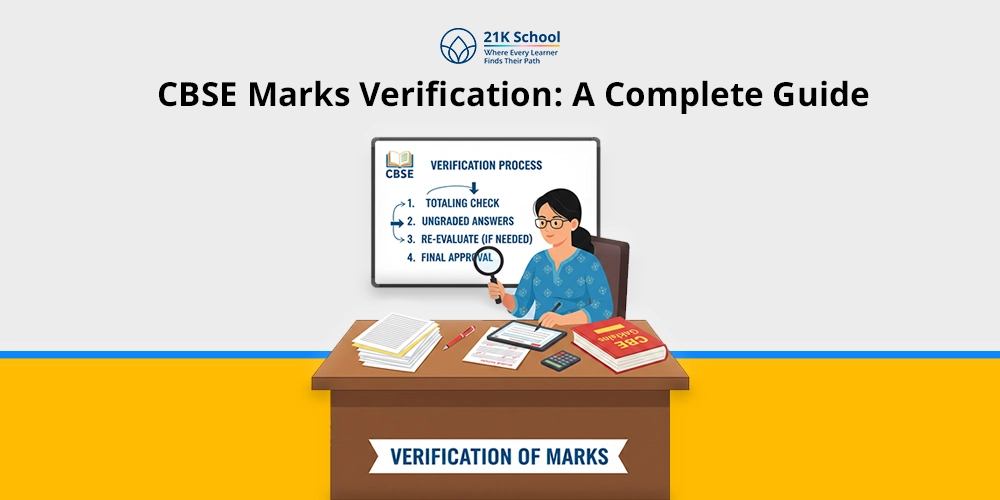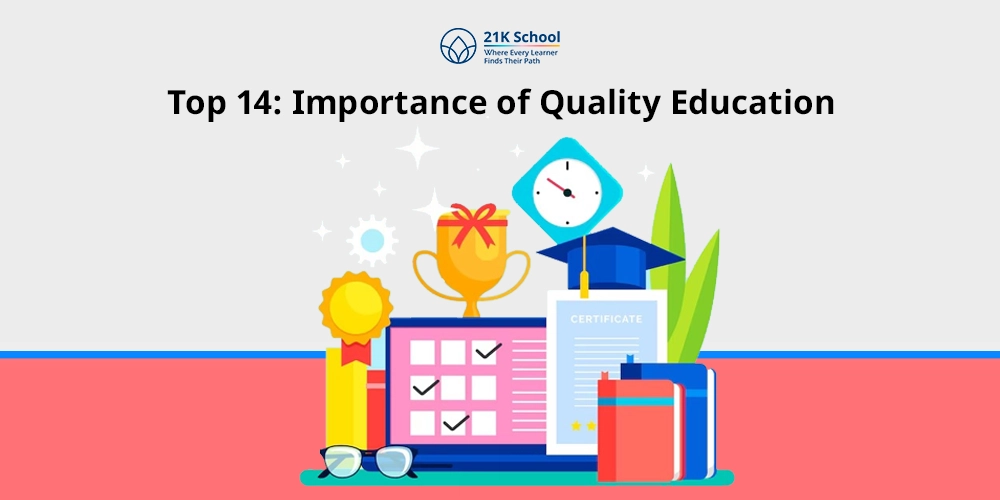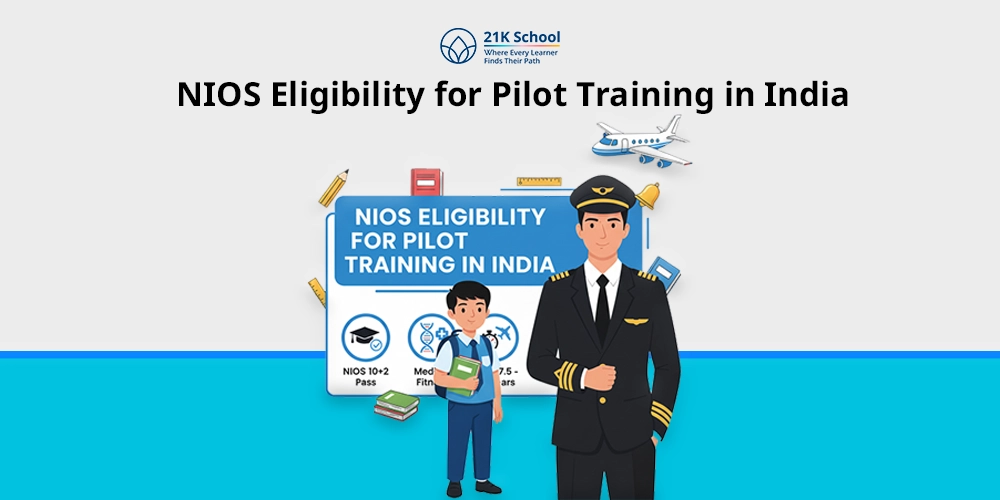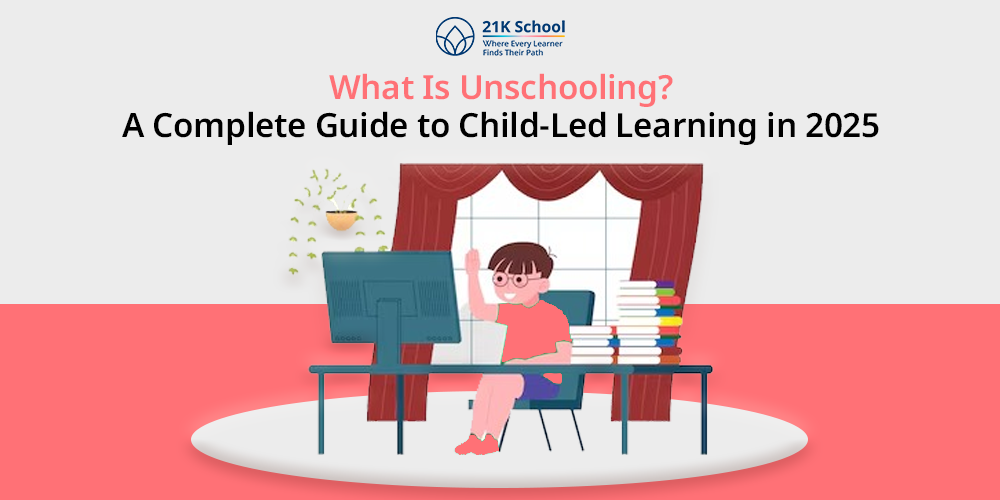
In today’s fast-paced and competitive world, more parents are looking for alternatives to traditional education. Rigid schedules, standardised tests, and one-size-fits-all teaching often leave children feeling stressed and disengaged.
In response, a growing number of families are embracing unschooling—a flexible, child-led approach to education that values curiosity over curriculum.
In this comprehensive guide, we’ll dive into what unschooling means, how it works, its benefits and challenges, and how it compares to homeschooling.
Table of Contents
- What is Unschooling?
- Key Principles of Unschooling
- Benefits of Unschooling
- Challenges of Unschooling
- Is Unschooling Legal?
- Common Myths and Misconceptions About Unschooling
- Unschooling at Different Ages
- Famous Unschoolers and Their Success Stories
- Unschooling vs Homeschooling: What’s the Difference?
- Final Thoughts
What is Unschooling?
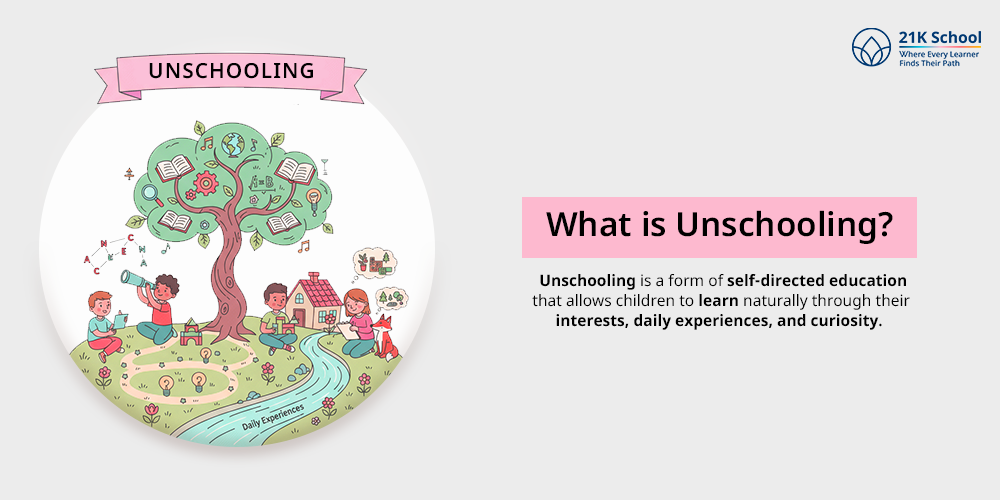
Unschooling is a form of self-directed education that allows children to learn naturally through their interests, daily experiences, and curiosity.
Unlike traditional schooling or even homeschooling , unschooling doesn’t rely on a structured syllabus, fixed subjects, or formal assessments.
Instead, learning unfolds organically as children ask questions, explore their surroundings, and engage in activities they enjoy.
Parents act as facilitators, not instructors. They provide resources, introduce new ideas, and encourage exploration without controlling the learning process.
This gives children a deep sense of autonomy and respect, which in turn fosters motivation, independence, and lifelong learning .
Key Principles of Unschooling
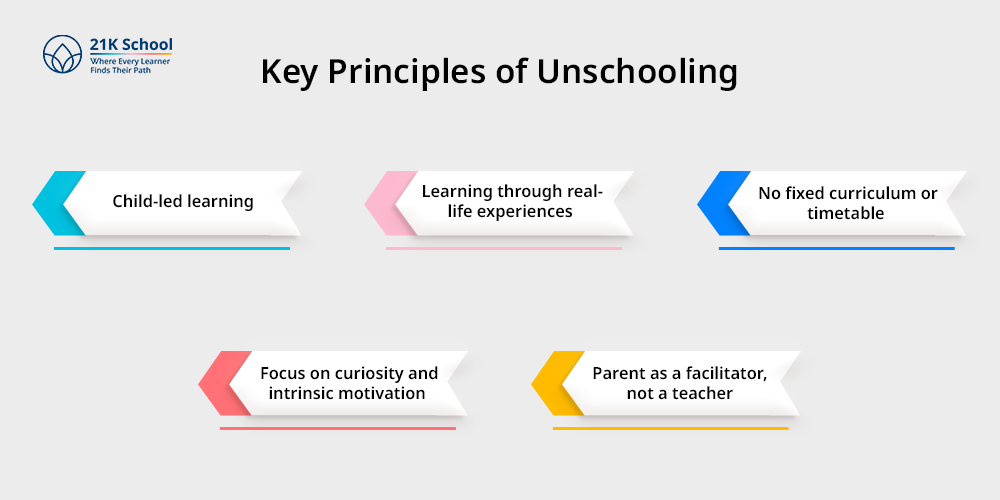
While unschooling can look very different from one family to another, it is guided by a few key principles that make it unique and effective:
1. Child-led learning
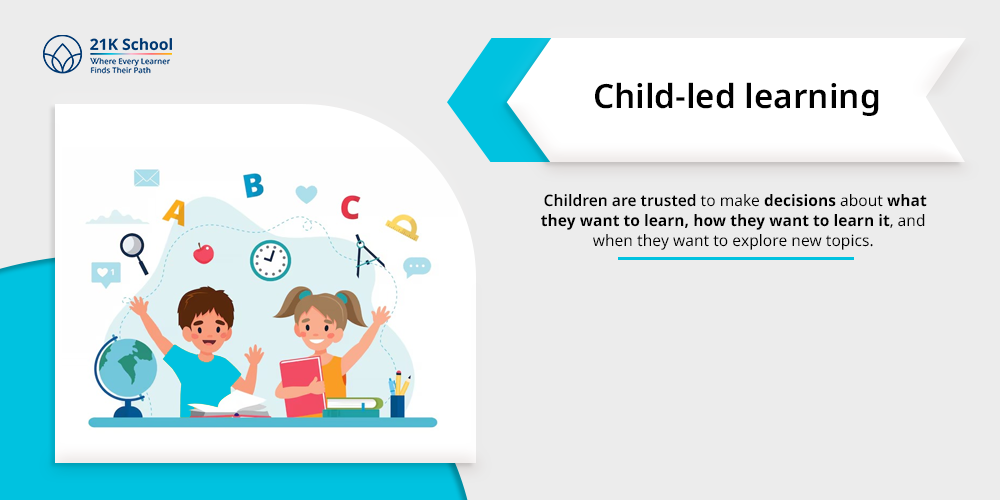
Children are trusted to make decisions about what they want to learn, how they want to learn it, and when they want to explore new topics.
Instead of being passive recipients of information, they become active participants in their education.
2. Learning through real-life experiences
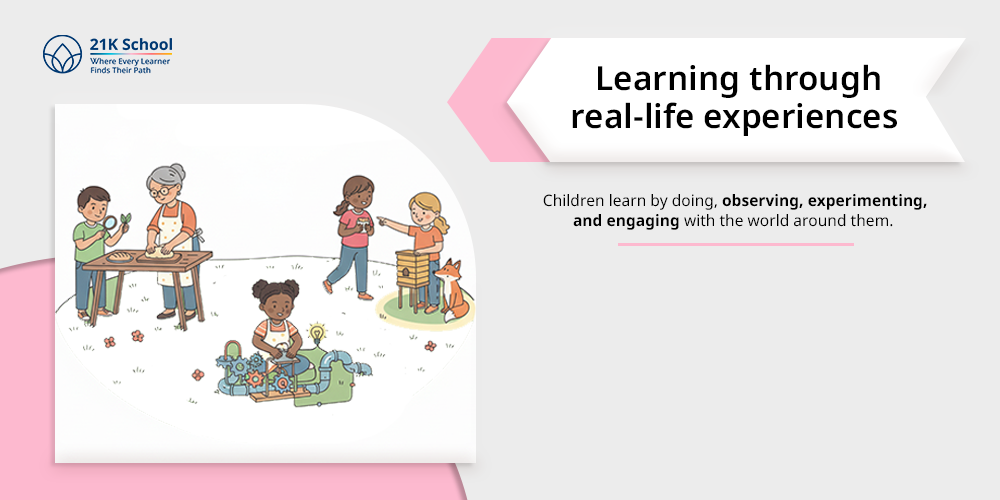
In unschooling, education doesn’t come only from books or classes; it comes from life itself. Children learn by doing, observing, experimenting, and engaging with the world around them.
For example, a trip to the grocery store can teach budgeting, reading, and nutrition. A walk in the park can spark questions about ecosystems, seasons, and animal behaviour.
3. No fixed curriculum or timetable
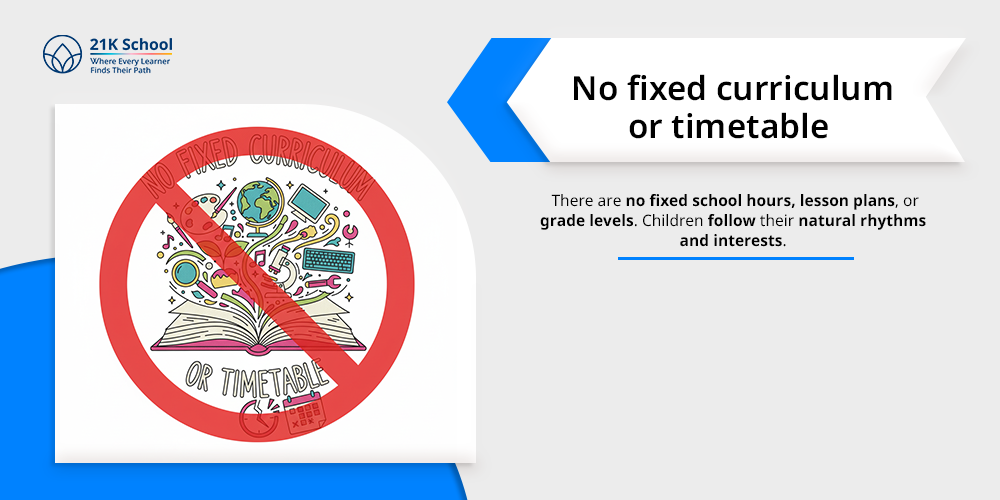
There are no fixed school hours, lesson plans, or grade levels. Children follow their natural rhythms and interests.
If a child wants to spend three weeks diving into astronomy, they can. If they switch to gardening next month, that’s fine too.
4. Focus on curiosity and intrinsic motivation
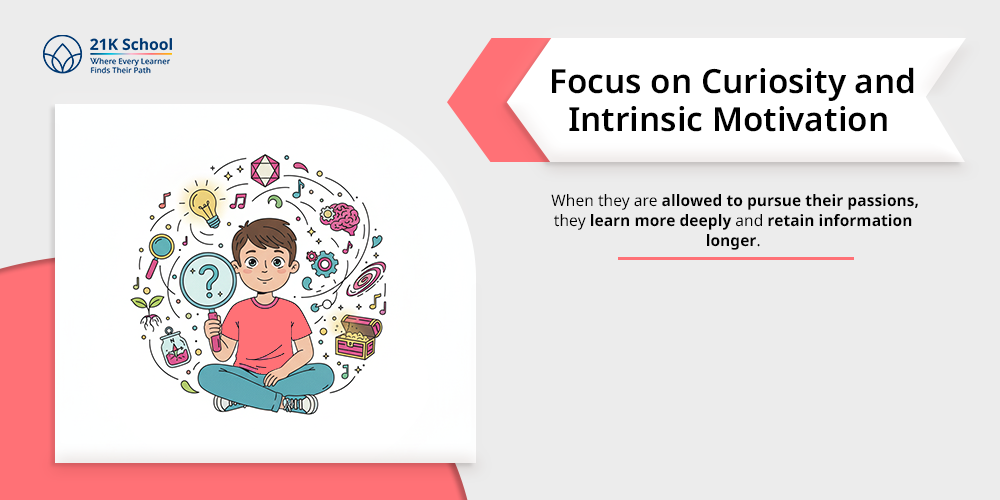
Unschooling relies on the idea that all children are naturally curious. When they are allowed to pursue their passions, they learn more deeply and retain information longer.
There’s no need for rewards or punishments; curiosity becomes the driving force.
5. Parent as a facilitator, not a teacher

Parents in unschooling homes don’t stand at a whiteboard and lecture.
They observe their child’s interests, suggest resources, introduce new experiences, and connect them with tools that might help their learning journey.
They create a positive learning environment that is rich, stimulating, and supportive.
Benefits of Unschooling
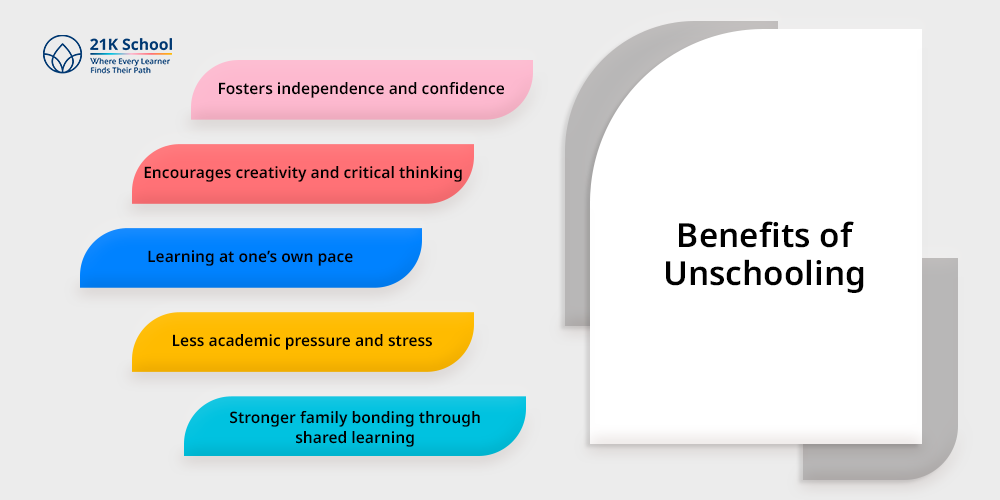
Families who choose unschooling often speak of a transformation, not just in their child’s education but in their overall well-being. The benefits are both academic and emotional:
1. Fosters independence and confidence

By making decisions about their learning, children build independence and self-trust.
They learn to set their own goals, overcome challenges, and evaluate their progress. This kind of autonomy often leads to higher self-esteem and a greater sense of purpose.
Also read: 10 Ways You Can Support Your Child to Study Independently from Home
2. Encourages creativity and critical thinking

In a system where there’s no fear of getting the wrong answer or failing a test, children are free to explore ideas and take risks.
This freedom nurtures creativity and helps them develop their critical thinking and problem-solving skills .
3. Learning at one’s own pace
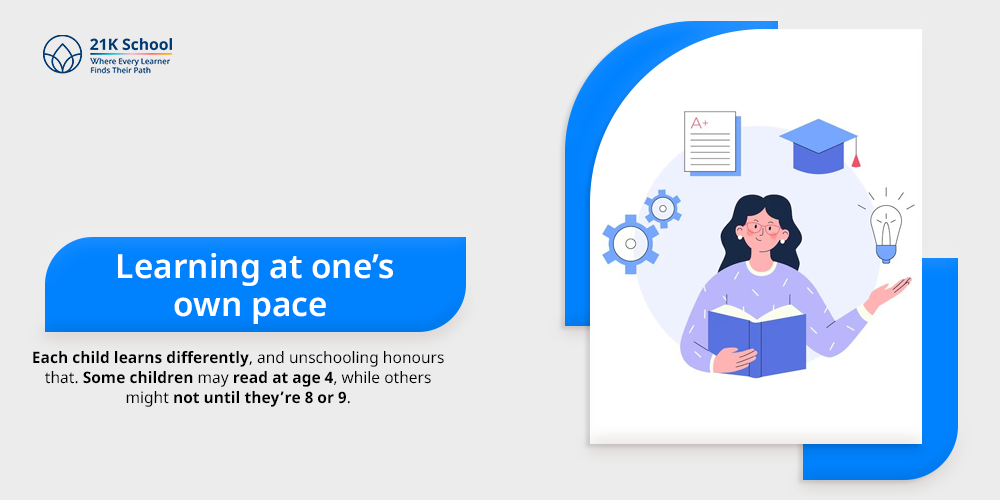
Each child learns differently, and unschooling honours that. Some children may read at age 4, while others might not until they’re 8 or 9.
In an unschooling environment, that’s perfectly okay. There’s no pressure to meet arbitrary milestones.
4. Less academic pressure and stress

Unschooling removes the burden of grades, homework, and tests. Children are not pushed to memorise facts or compete with peers.
As a result, they often feel more relaxed and enjoy learning instead of dreading it.
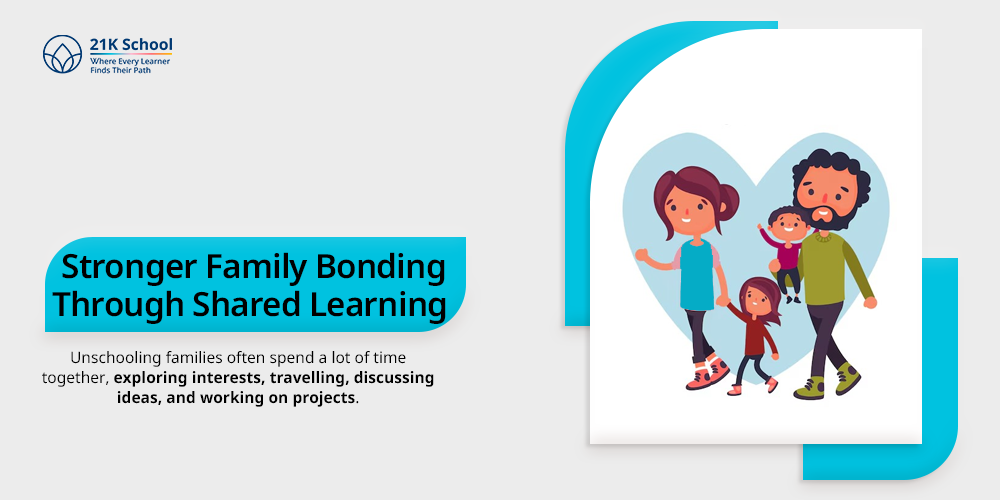
Unschooling families often spend a lot of time together, exploring interests, travelling, discussing ideas, and working on projects.
Learning becomes a shared journey, not something that happens away from home. This highly improves the parent-child relationship .
Challenges of Unschooling
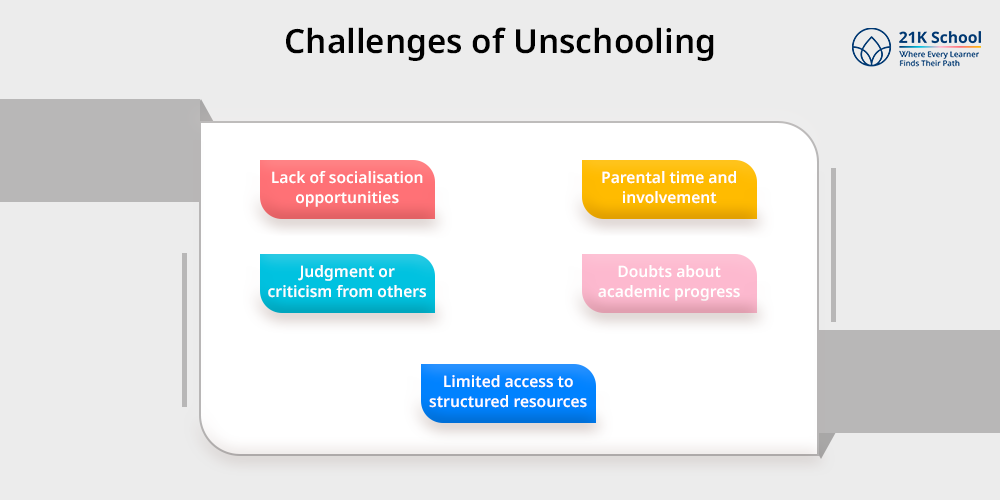
Unschooling is a rewarding path, but it also comes with challenges. Understanding them can help parents prepare and adapt more effectively:

Since unschoolers don’t attend traditional schools, they may miss out on regular interactions with peers. However, this doesn’t mean they don’t socialise.
Many families organise meetups, field trips, playgroups, and community events.
2. Parental time and involvement

Unschooling requires a lot of presence and involvement from parents. It’s not a hands-off approach.
Parents need to be curious, observant, and proactive in helping their children explore the world. This can be demanding, especially for working parents.
3. Judgment or criticism from others
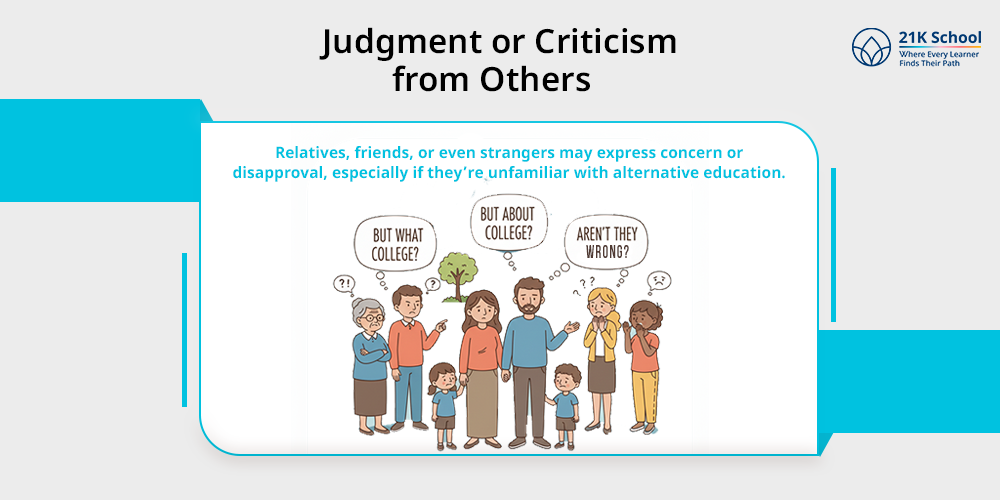
Unschooling can be misunderstood. Relatives, friends, or even strangers may express concern or disapproval, especially if they’re unfamiliar with alternative education.
Parents may face pressure to justify their choice.
4. Doubts about academic progress
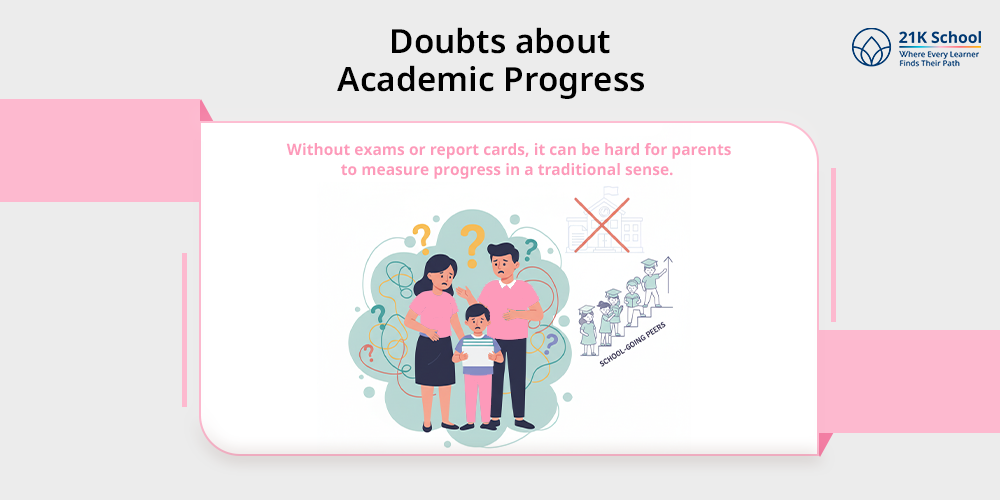
Without exams or report cards, it can be hard for parents to measure progress in a traditional sense. This may lead to anxiety, especially when compared to school-going peers.
5. Limited access to structured resources
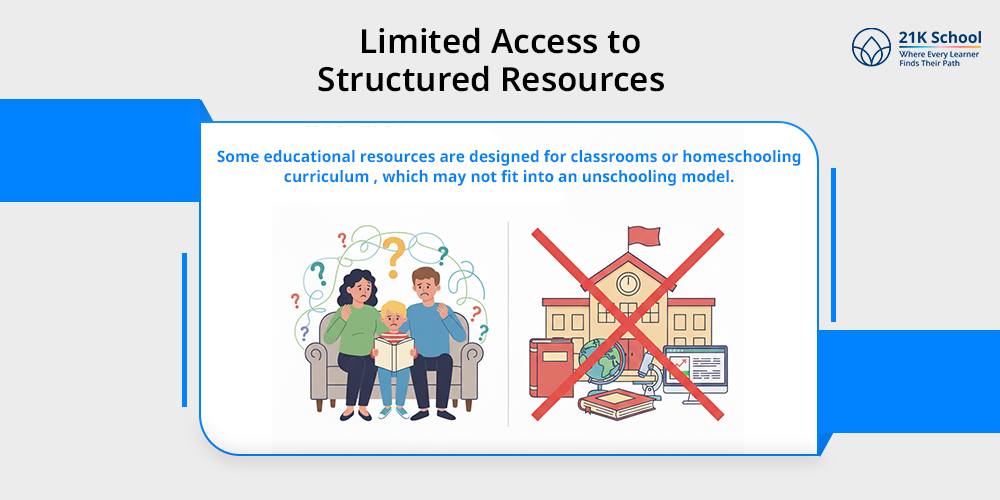
Some educational resources are designed for classrooms or homeschooling curriculum , which may not fit into an unschooling model.
Parents need to be resourceful—using documentaries, online platforms, workshops, museums, and libraries.
Is Unschooling Legal?
In most countries, unschooling is not illegal, but it may not be formally recognised either. It typically falls under the broader category of homeschooling.
Find out: Is homeschooling legal in India?
India does not have a specific law supporting or banning unschooling. It exists in a legal grey area. However, many Indian families have adopted unschooling successfully without legal consequences.
Some choose to register with boards like NIOS (National Institute of Open Schooling) to maintain academic records and eligibility for higher education later. This helps balance the freedom of unschooling with formal recognition.
Parents should research state-level education policies and stay updated. Legal support groups and homeschooling forums can provide useful guidance.
Common Myths and Misconceptions About Unschooling
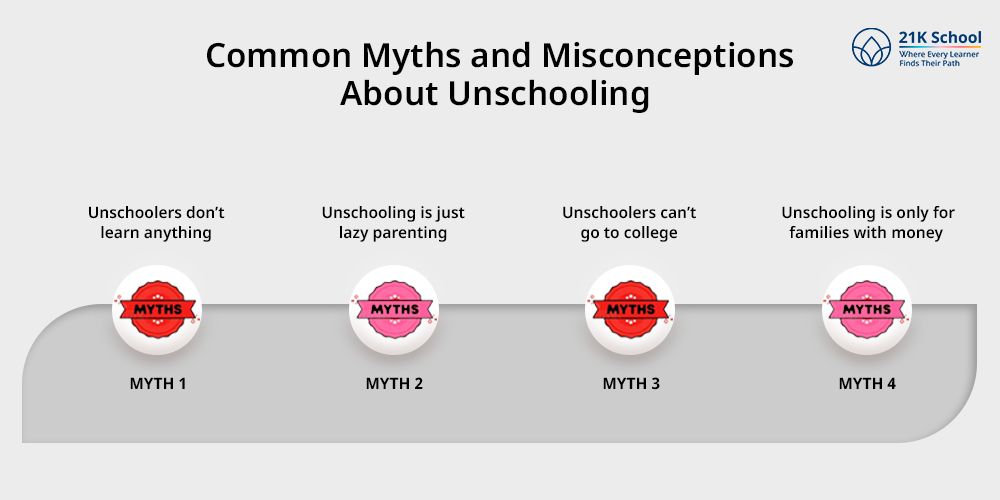
Although unschooling is gaining traction, it is still very poorly understood. Here are some myths, debunked:
Myth 1: Unschoolers don’t learn anything
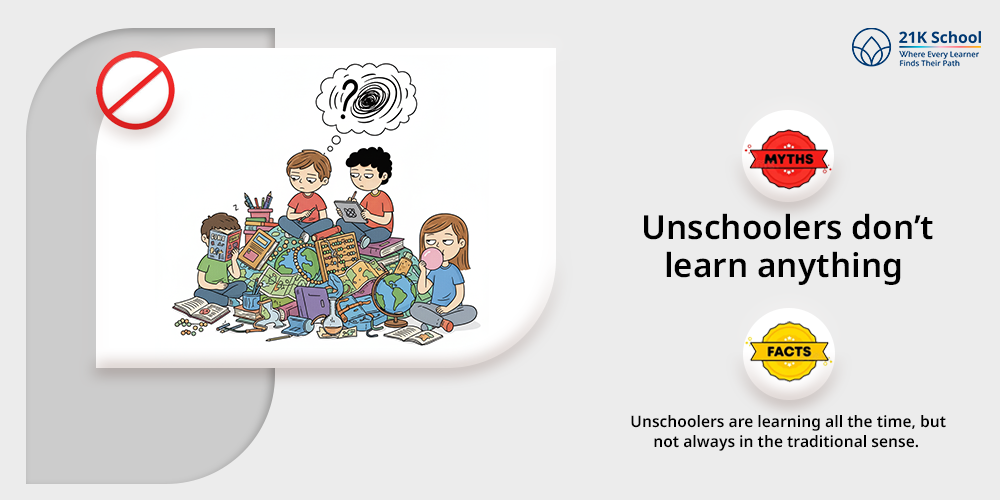
Reality: Unschoolers are learning all the time, but not always in the traditional sense. Though they may not be memorising facts for an exam, they are mastering skills through real-life experiences.
Myth 2: Unschooling is just lazy parenting
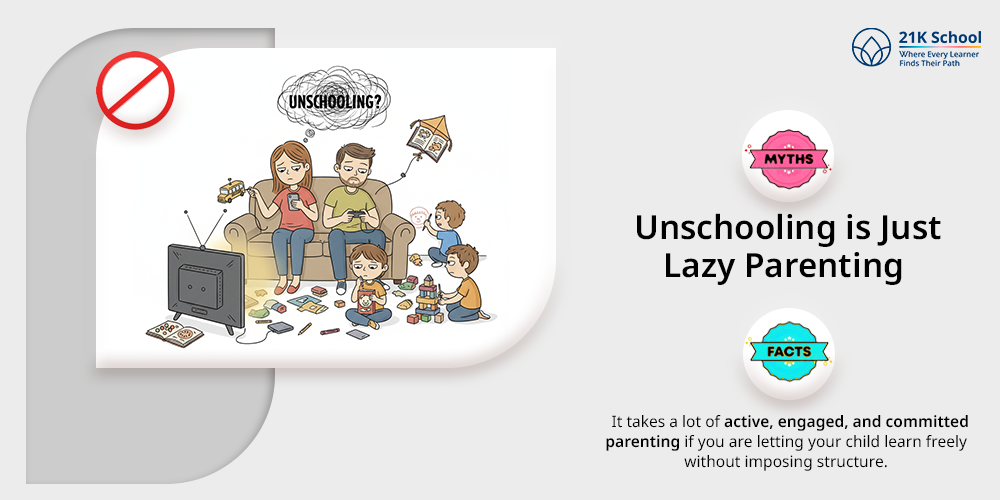
Reality: It takes a lot of active, engaged, and committed parenting if you are letting your child learn freely without imposing structure.
Myth 3: Unschoolers can’t go to college

Reality: Many colleges and universities accept unschoolers, especially after they show they can learn in a self-directed way and have great writing and thinking skills.
Myth 4: Unschooling is only for families with money
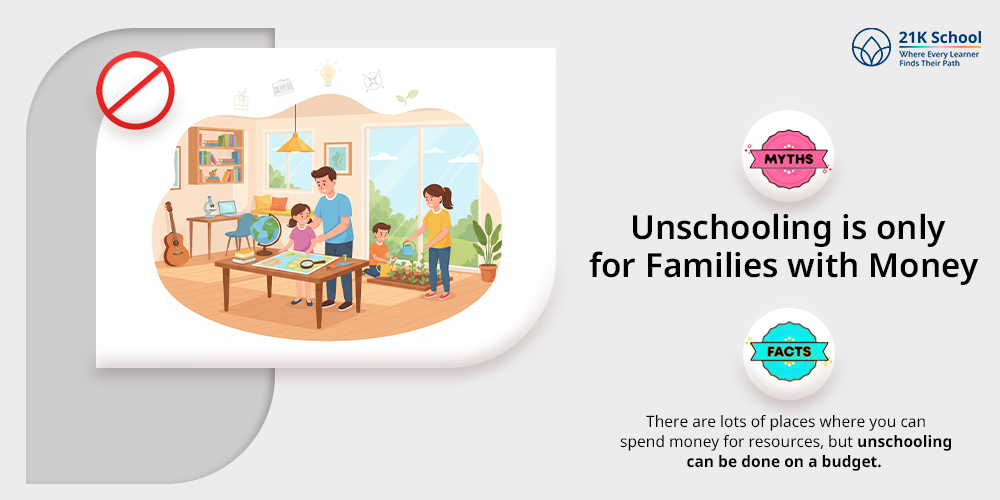
Reality: There are lots of places where you can spend money for resources, but unschooling can be done on a budget. Innovative families are obtaining rich learning from libraries, free public resources, online courses, and community programs.
Unschooling at Different Ages
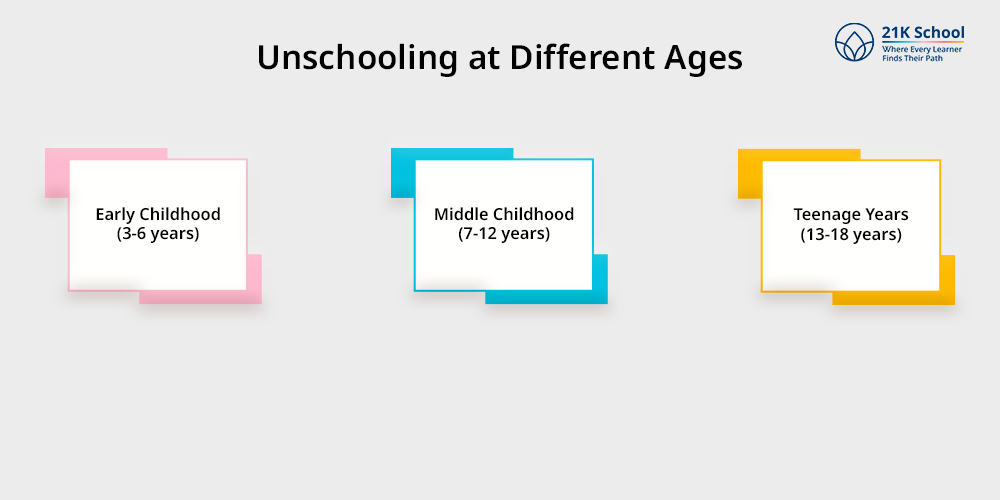
Unschooling beautifully aligns with a child’s developmental stages. Here is a glimpse of some ways it can look:
1. Early Childhood (3-6 years)

This is a fun stage; children are naturally curious and want to explore. Unschooling in these years can include:
- Playing with tangible pieces like blocks or puzzles
- Going on nature walks
- Reading a story
- Free drawing
- Asking “But why?” for everything
2. Middle Childhood (7-12 years)

At this stage, children want to further explore the things they enjoy. Examples are:
- Running a lemonade stand
- Creating a YouTube channel
- Immersing themselves in their books or creative writing
3. Teenage Years (13-18 years)

Teens may be more focused and goal-oriented. They may have the ability to:
- Take part in online courses or internships
- Find volunteer opportunities or maybe even part-time work
- Create a portfolio, especially for college or entrepreneurship
Many unschooled teens go on to attend college or equivalent higher education via portfolios, college-level entrance exams (CLEP), or credits received at a local community college.
Famous Unschoolers and Their Success Stories
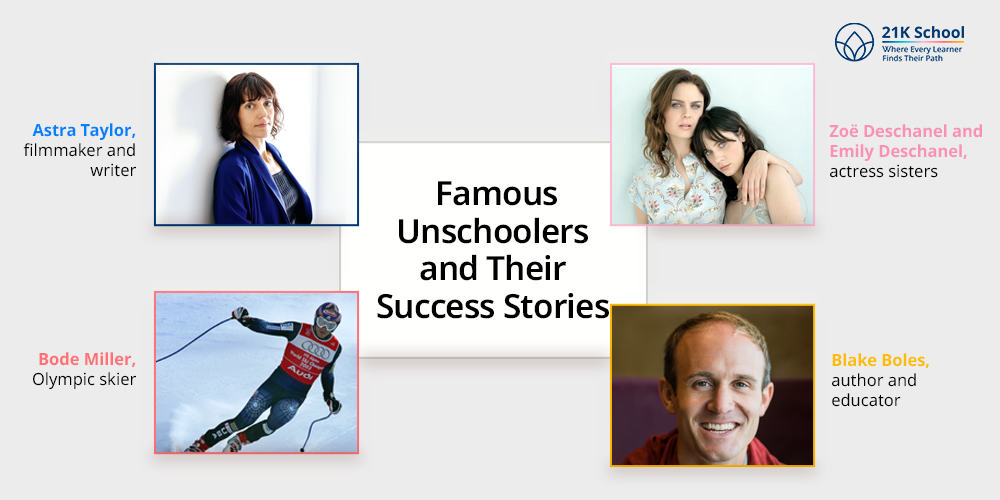
While it may be widely believed that unschooling restricts future success, many recognisable people have either been unschooled or educated in an unconventional manner:
- Astra Taylor, filmmaker and writer, was unschooled and then went to college to study philosophy.
- Zoë Deschanel and Emily Deschanel, actress sisters who grew up in a very creative, loosely structured home environment.
- Bode Miller, Olympic skier, was an unschooler in the mountains of New Hampshire.
- Blake Boles, author and educator, advocates for self-directed learning and runs programs for unschooling teens.
Furthermore, many entrepreneurs, artists, and creators have publicly counted their success as the result of education outside of the traditional system.
Unschooling vs Homeschooling: What’s the Difference?
| Aspect | Unschooling | Homeschooling |
|---|---|---|
| Approach to Learning | Child-led and interest-based | Parent-led, structured learning |
| Curriculum | No formal curriculum; learning happens naturally | Follows a set curriculum, often similar to school syllabi |
| Daily Structure | Flexible; no fixed schedule | Usually follows a timetable with planned lessons |
| Parental Role | The parent is a guide or facilitator | The parent acts as a teacher or instructor |
| Assessment Methods | No tests or grades; learning is observed | May include tests, quizzes, and graded assignments |
| Learning Resources | Real-life experiences, conversations, media, hands-on tools | Textbooks, workbooks, online classes, educational software |
| Socialisation | Happens through life experiences or intentional meetups | Often includes co-ops, groups, or extracurricular activities |
| Flexibility | Highly adaptable to the child’s pace and interests | Moderate flexibility within a structured plan |
| Focus | Curiosity, exploration, and intrinsic motivation | Academic achievement, covering subjects thoroughly |
| Philosophy | Education is a natural part of life | Education is structured and guided at home |
Also, see the differences between homeschooling and traditional schooling .
Final Thoughts
Unschooling is not for everyone, but for families who embrace it, it offers a deeply personal and rewarding way to learn.
It challenges traditional notions of education and invites us to trust in the child’s ability to learn naturally.
As more parents look for flexible and student-centred learning , unschooling continues to grow as a viable and enriching alternative.
Whether you’re just curious or seriously considering it, understanding the principles and realities of unschooling is a great place to start.

